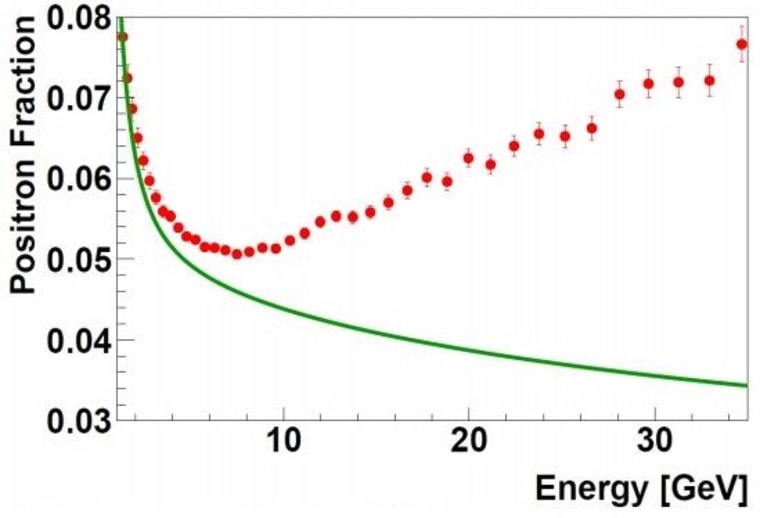Scientists behind the $2 billion Alpha Magnetic Spectrometer experiment are reporting new data pointing toward the potential detection of dark matter particles.
If the findings are eventually firmed up, they could explain a mystery that has puzzled physicists for decades: What's behind the 23 percent of the universe that we can't detect except through its gravitational influence?
The answer could be a type of particle, or particles, that we just haven't been able to detect yet. The bus-sized AMS apparatus, which was attached to the exterior of the International Space Station in 2011, is designed to make that detection.
For three years, an international team of researchers led by MIT physicist Sam Ting has been collecting data about cosmic-ray collisions. Such readings can't be collected on Earth because our planet's atmosphere blocks most of the cosmic rays coming from the far corners of the universe.
Ting and his colleagues have been watching for telltale patterns in the shifting balance between electrons and positrons, their antimatter equivalent, at higher and higher energies. Now that 41 billion cosmic-ray events have been analyzed, they're reporting a decline in the proportion of positrons, followed by a rise and then another drop.
"This is the first experimental observation of the positron fraction maximum after half a century of cosmic rays experiments," Ting said in a news release from Europe's CERN particle physics center. The rise begins at the energy level of 8 billion electronvolts, hits a peak at about 275 billion electronvolts, and then starts heading for a decline.
The rise and fall of the positron ratio could point to the existence of a previously undetected particle or particles. Such particles — for instance, neutralinos — could account for that mysterious dark matter.
Why does dark matter matter?
Physicists assume that dark matter exists because it's required under current theory to explain the motions of galaxies and giant galaxy clusters. Every galaxy is thought to be surrounded by a halo of dark matter that helps bind it together gravitationally. Studies also suggest that webs of dark matter serve as the unseen scaffolding for cosmic structure at the largest scale.
If dark matter particles exist, they should be zipping through us continuously, but in such a way that they hardly interact with "ordinary" matter. It's thought that at any given time, a liter bottle of soda contains roughly one particle of dark matter.
When CERN's Large Hadron Collider starts up again next year, physicists plan to resume their search for signs of dark matter — a search that's complementary to the AMS cosmic-ray experiment in space.
In addition to dark matter, physicists have been puzzling over the mystery of dark energy — a factor that appears to be causing the accelerating expansion of the universe. Although both mysteries are "dark," and may involve the existence of as-yet-undetected subatomic particles, they're only tangentially related. Dark energy is thought to account for 73 percent of the universe's mass-energy content, compared with 23 percent for invisible dark matter, and 4 percent for the kind of matter we can see.

Mission not yet accomplished
The AMS findings are being published in Physical Review Letters, but Ting said it would be premature to declare that dark matter has been detected. It's still possible that the rise in the proportion of positrons has a less exotic cause — for example, emissions from far-off pulsars.
Precise measurements of the rate at which the positron ratio falls off could tell physicists whether the spike is due to pulsar emissions or the annihilation of dark matter particles. So far, the measurements are "tantalizingly consistent with dark matter particles with mass of the order of 1 TeV [1 trillion electronvolts]," CERN said.
For comparison's sake, the mass of the proton is roughly 1 billion electronvolts.
The collection and analysis of data could go on for years longer — which means you shouldn't hold your breath waiting for the invention of "Futurama"-style dark matter engines.
Physical Review Letters published two papers from the AMS Collaboration on Thursday: "High Statistics Measurement of the Positron Fraction in Primary Cosmic Rays of 0.5–500 GeV with the Alpha Magnetic Spectrometer on the International Space Station," and "Electron and Positron Fluxes in Primary Cosmic Rays Measured with the Alpha Magnetic Spectrometer on the International Space Station." It also published a synopsis titled "More Dark Matter Hints From Cosmic Rays?"